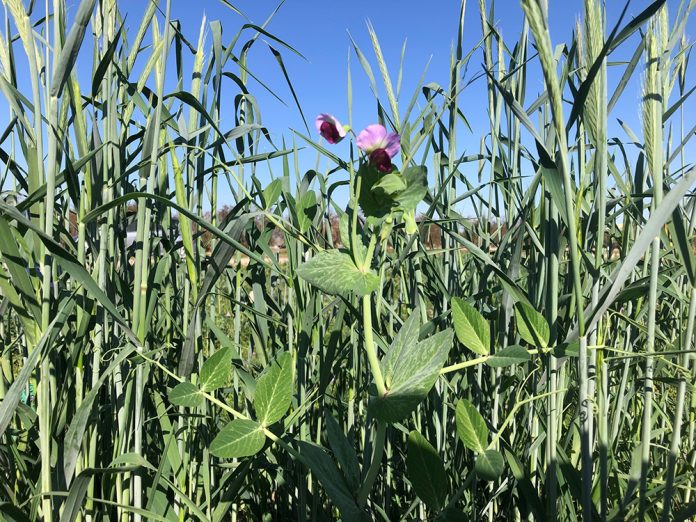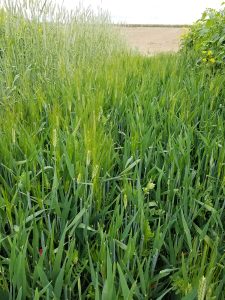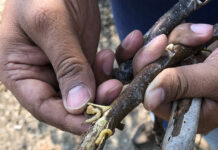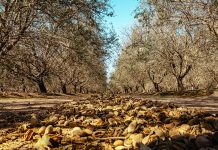
Soil health is defined as the continued capacity of soil to function as a vital living ecosystem that sustains plants, animals and humans, according to USDA. This includes providing space for root growth and respiration; moving water rapidly and allowing water to infiltrate in the soil profile; storing water for future crop use; and providing habitat for soil organisms including soil microbes. When we build soil health, we are increasing the capacity of our soil to do the jobs we need it to do, which can improve crop production.
Cover crops are plant species selected and grown for their protective and beneficial contributions to soil health. They help meet three of the soil health principles: maintaining a living root, increasing plant diversity in the rotation and maintaining soil coverage. Cover crops help keep ground productive in the long term by physically protecting the soil from erosion, maintaining soil structure and building soil tilth and fertility. Aboveground and belowground, cover crop biomass builds soil organic matter, which can improve nutrient cycling and retention, water holding capacity, water penetration and infiltration. Both cover crop residue and roots provide essential sources of food for soil macrofauna and microbial life. Soil microbial communities contribute toward disease suppression and nutrient cycling, especially nitrogen. Soil organisms are also essential for building and maintaining soil structure including aggregate stability and soil porosity. Improved soil structure in the form of better soil water holding capacity may reduce irrigation applications in future years.

Cost to Produce
All these potential benefits come with a cost to produce; a 2022 UCCE Cost Study estimates that to be $156/acre. This cost study models the planting and management of a winter cover crop in a summer crop rotation planted in the lower Sacramento Valley of California. The rotation may include processing tomatoes, corn, sunflower, safflower, sorghum and/or dry beans as well as other summer annual crops. This study models a field following harvest of processing tomatoes in the fall and a planned rotation into a spring-planted field crop. Despite the benefits, cover cropping is not realistic for all operations. From timing and logistics to equipment, there are numerous reasons why a farm cannot adopt this practice. Farmers and researchers are exploring more ways to cover crop than the scenario in this study.
The useability of this study in different regions or operations lies in understanding the costs accounted for in the $156/acre. The costs include cash and labor costs associated with seed, legume inoculum, planting and termination activities (mowing and discing two times). Because cover crops are part of a rotation between cash crops, some soil preparation practices were not charged to the cover crop. Preplant practices, including ripping the furrows, disking and rolling two times and landplaning, are considered preparatory practices for the cash crop, not the cover crop. Historically, cover crops are exclusively rainfed. However, variation in annual winter rainfall amount and timing is increasingly common. Therefore, two irrigation events are included in one out of every three years. Make note that the cost of water varies widely across regions and operations and may differ considerably from $5.42 per acre inch used in the study. This study includes a sprinkler irrigation system but assumes the equipment was not purchased for cover crop production. Thus, only labor and water costs are attributed. Each table has a “Your Costs” column in which users can add any additional costs for their operations. For example, renting sprinkler irrigation equipment will have higher irrigation costs than those listed.
Despite the multiple benefits from cover crops, nitrogen is the only economic return included in the study. We estimate 100 pounds of nitrogen are fixed per acre by the mixed legume-cereal cover crop, and 30% of this nitrogen mineralizes and becomes plant-available to the following crop in the first season. Thus, 30 lb/acre of nitrogen are attributed as a return from the cover crop at a rate of $1.20/lb ($36 return). Both the amount of plant-available nitrogen and value of nitrogen are conservative estimates. Few studies document the other benefits in dollars. Cover crops can increase soil workability, reducing labor and fuel costs for field work. Planted in rotation or in otherwise fallow fields, cover crops can suppress winter weeds. Weed suppression can reduce the need for herbicide sprays used to maintain a winter fallow. This can save up to $65/acre, including materials, fuel and labor. Cover crops can capture residual soil nitrogen to reduce nutrient runoff and leaching. This may ultimately contribute to the maintenance and protection of downstream water quality while simultaneously returning nitrogen to the subsequent crop post-cover-crop-incorporation. Recruitment of beneficial insects and pollinators is another benefit with potential economic returns among others.
Maintaining the viability of our California farmland is critical for our food supply and protecting our agricultural economy. Cover crops can play a pivotal role in building and maintaining soil health and ensuring land remains farmable for the long term. The true cost of cover crops is complicated given the hard-to-measure benefits that dominate the decision to grow cover crops. Nonetheless, accessing these benefits through a cover crop comes at an estimated cost of $156/acre. For some, that may be a screaming deal. For others, this practice may not be logistically possible or economically feasible.


















